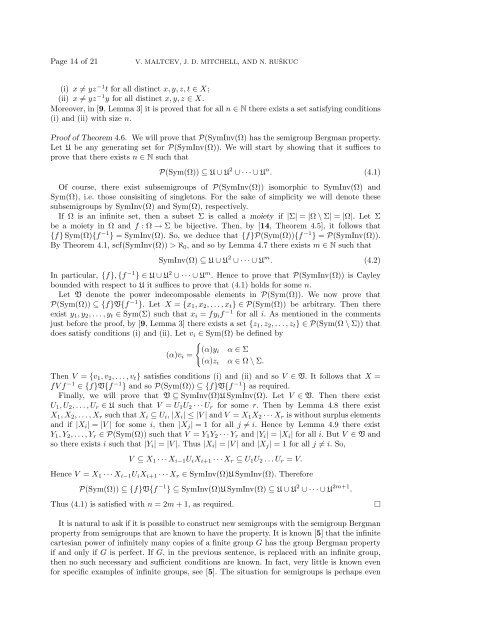The Bergman property for semigroups
The Bergman property for semigroups
The Bergman property for semigroups
You also want an ePaper? Increase the reach of your titles
YUMPU automatically turns print PDFs into web optimized ePapers that Google loves.
Page 14 of 21<br />
V. MALTCEV, J. D. MITCHELL, AND N. RUŠKUC<br />
(i) x ≠ yz −1 t <strong>for</strong> all distinct x, y, z, t ∈ X;<br />
(ii) x ≠ yz −1 y <strong>for</strong> all distinct x, y, z ∈ X.<br />
Moreover, in [9, Lemma 3] it is proved that <strong>for</strong> all n ∈ N there exists a set satisfying conditions<br />
(i) and (ii) with size n.<br />
Proof of <strong>The</strong>orem 4.6. We will prove that P(SymInv(Ω) has the semigroup <strong>Bergman</strong> <strong>property</strong>.<br />
Let U be any generating set <strong>for</strong> P(SymInv(Ω)). We will start by showing that it suffices to<br />
prove that there exists n ∈ N such that<br />
P(Sym(Ω)) ⊆ U ∪ U 2 ∪ · · · ∪ U n . (4.1)<br />
Of course, there exist sub<strong>semigroups</strong> of P(SymInv(Ω)) isomorphic to SymInv(Ω) and<br />
Sym(Ω), i.e. those consisiting of singletons. For the sake of simplicity we will denote these<br />
sub<strong>semigroups</strong> by SymInv(Ω) and Sym(Ω), respectively.<br />
If Ω is an infinite set, then a subset Σ is called a moiety if |Σ| = |Ω \ Σ| = |Ω|. Let Σ<br />
be a moiety in Ω and f : Ω → Σ be bijective. <strong>The</strong>n, by [14, <strong>The</strong>orem 4.5], it follows that<br />
{f} Sym(Ω){f −1 } = SymInv(Ω). So, we deduce that {f}P(Sym(Ω)){f −1 } = P(SymInv(Ω)).<br />
By <strong>The</strong>orem 4.1, scf(SymInv(Ω)) > ℵ 0 , and so by Lemma 4.7 there exists m ∈ N such that<br />
SymInv(Ω) ⊆ U ∪ U 2 ∪ · · · ∪ U m . (4.2)<br />
In particular, {f}, {f −1 } ∈ U ∪ U 2 ∪ · · · ∪ U m . Hence to prove that P(SymInv(Ω)) is Cayley<br />
bounded with respect to U it suffices to prove that (4.1) holds <strong>for</strong> some n.<br />
Let V denote the power indecomposable elements in P(Sym(Ω)). We now prove that<br />
P(Sym(Ω)) ⊆ {f}V{f −1 }. Let X = {x 1 , x 2 , . . . , x t } ∈ P(Sym(Ω)) be arbitrary. <strong>The</strong>n there<br />
exist y 1 , y 2 , . . . , y t ∈ Sym(Σ) such that x i = fy i f −1 <strong>for</strong> all i. As mentioned in the comments<br />
just be<strong>for</strong>e the proof, by [9, Lemma 3] there exists a set {z 1 , z 2 , . . . , z t } ∈ P(Sym(Ω \ Σ)) that<br />
does satisfy conditions (i) and (ii). Let v i ∈ Sym(Ω) be defined by<br />
{<br />
(α)y i α ∈ Σ<br />
(α)v i =<br />
(α)z i α ∈ Ω \ Σ.<br />
<strong>The</strong>n V = {v 1 , v 2 , . . . , v t } satisfies conditions (i) and (ii) and so V ∈ V. It follows that X =<br />
fV f −1 ∈ {f}V{f −1 } and so P(Sym(Ω)) ⊆ {f}V{f −1 } as required.<br />
Finally, we will prove that V ⊆ SymInv(Ω)U SymInv(Ω). Let V ∈ V. <strong>The</strong>n there exist<br />
U 1 , U 2 , . . . , U r ∈ U such that V = U 1 U 2 · · · U r <strong>for</strong> some r. <strong>The</strong>n by Lemma 4.8 there exist<br />
X 1 , X 2 , . . . , X r such that X i ⊆ U i , |X i | ≤ |V | and V = X 1 X 2 · · · X r is without surplus elements<br />
and if |X i | = |V | <strong>for</strong> some i, then |X j | = 1 <strong>for</strong> all j ≠ i. Hence by Lemma 4.9 there exist<br />
Y 1 , Y 2 , . . . , Y r ∈ P(Sym(Ω)) such that V = Y 1 Y 2 · · · Y r and |Y i | = |X i | <strong>for</strong> all i. But V ∈ V and<br />
so there exists i such that |Y i | = |V |. Thus |X i | = |V | and |X j | = 1 <strong>for</strong> all j ≠ i. So,<br />
V ⊆ X 1 · · · X i−1 U i X i+1 · · · X r ⊆ U 1 U 2 . . . U r = V.<br />
Hence V = X 1 · · · X i−1 U i X i+1 · · · X r ∈ SymInv(Ω)U SymInv(Ω). <strong>The</strong>re<strong>for</strong>e<br />
P(Sym(Ω)) ⊆ {f}V{f −1 } ⊆ SymInv(Ω)U SymInv(Ω) ⊆ U ∪ U 2 ∪ · · · ∪ U 2m+1 .<br />
Thus (4.1) is satisfied with n = 2m + 1, as required.<br />
It is natural to ask if it is possible to construct new <strong>semigroups</strong> with the semigroup <strong>Bergman</strong><br />
<strong>property</strong> from <strong>semigroups</strong> that are known to have the <strong>property</strong>. It is known [5] that the infinite<br />
cartesian power of infinitely many copies of a finite group G has the group <strong>Bergman</strong> <strong>property</strong><br />
if and only if G is perfect. If G, in the previous sentence, is replaced with an infinite group,<br />
then no such necessary and sufficient conditions are known. In fact, very little is known even<br />
<strong>for</strong> specific examples of infinite groups, see [5]. <strong>The</strong> situation <strong>for</strong> <strong>semigroups</strong> is perhaps even<br />
□
















